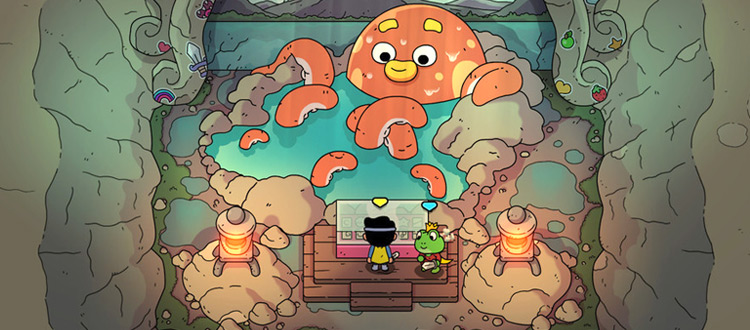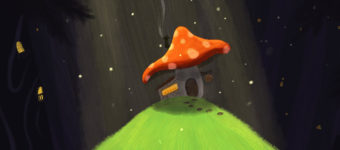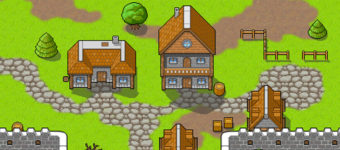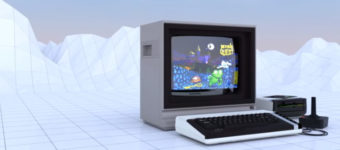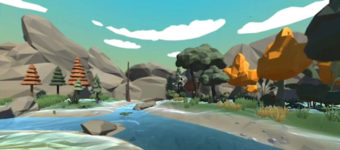Best Free GameMaker Studio Tutorials For All Skill Levels
GameMaker Studio is a powerful 2D engine developed by YoYo Games. With its drag-and-drop interface and a host of features, GameMaker simply makes game development easy.
Hit titles like Hotline Miami and Hyper Light Drifter have helped popularize GameMaker. It’s now supported by a sizable community of 2D game developers with new devs joining all the time.
With cross-platform support this program can deploy to every major platform, saving developers time by giving them access to several markets simultaneously. It also has its own scripting language—Game Maker Language—that can be used to create almost anything.
To get started learning this incredible program we have this list of tutorials on GameMaker so you can dive right into creating your dream game as soon as possible.
We’ve provided a variety of tutorials that cover several game genres so there’s guaranteed to be something in here for everyone.
Your First Game
This tutorial created from the folks at GameMaker studios will walk you through the basics for a top-down action game.
You’ll start with player movement and work your way into more advanced topics.
You’ll learn how to navigate the GameMaker interface and add your own scripts. With only a few lines of code, you’ll be able to move your character around the screen with only a keyboard.
Using a system of Events and Actions, GameMaker makes it easy to program advanced logic too.
Complete Platformer Tutorial
Shaun Spalding covers everything you need to get started making your own platformer in GameMaker Studio 2.
In this series Shaun makes use of the newest methods that get beginners up to speed quickly. Aimed at beginners and intermediate users alike, this series will have you leaping over pipes and jumping on Goombas in no time.
You start by setting up your game environment and then move on to player movement. You’ll learn how to create gravity and collisions in fewer than 40 lines of code.
2D Hack-n-Slash
Here’s a handy learning tool from HeartBeast that teaches beginners how to make a 2D Hack-n-Slash game in GameMaker Studio 2.
You’ll learn everything from how to animate characters to coding in GameMaker.
With step-by-step instructions you’ll learn the basics of GameMaker while working toward a playable game that you can use in your portfolio.
Over the course of this series you’ll learn many techniques that are applicable to almost any game style too.
And if you like this tutorial check out the instructor’s full pixel art course from Udemy.
Make An RPG in GameMaker
Here we have another video from HeartBeast (AKA Benjamin) who covers the basics of building a Role Playing Game.
This is aimed at total beginners who are itching to build their very own classic RPG.
Using retro RPGs like Final Fantasy and Chrono Trigger as a guide, Benjamin will show you how to use tiles to build a room and add collision events.
Next you’ll work on movement and getting your character to respond to input. As you progress through the series you’ll learn how to add custom behaviors and animations via GML.
Melee Attacks
This two-part guide by Shaun Spalding takes an in-depth look at melee combat in GameMaker.
The example used is a 2D platformer, but these techniques will work for any game.
Part 1 covers a state-machine to create a basic attack. In part 2 you’ll learn about making combo-chains and linking multiple attacks.
This is a code-heavy tutorial that focuses on the concepts behind creating a melee system. By the end you’ll have a strong understanding of using hit boxes for melee combat along with scripting for your own games.
Shaders: The Basics
Shaders are one of the most powerful and versatile tools in a game developer’s toolbox.
They can be used to create a range of effects and are present in most games.
It’s true that shaders are an advanced topic, but the rewards for using them are well worth the trouble of learning how.
In this video HeartBeast will guide you through shaders in GameMaker. He’ll show you how to use the shader editor to add some incredible visual effects to your games.
This tutorial starts with some simple demonstrations and concludes with making a custom greyscale shader in GameMaker.
Water Shader & Physics
Most game engines provide some type of physics engine and Game Maker is no exception.
Using physics it’s possible to create a variety of realistic animations and mechanics for your games.
This video, also from Shaun Spalding, concentrates on creating bodies of water for a 2D platformer. Using his own game PokeyPoke as a reference, Shaun will teach you how to implement a complex water effect.
Just note that in the introduction Shaun mentions this video is more focused on concepts rather than implementation.
This point is to get your imagination working and gain more insight into game development.
Farming RPG
This tutorial walks you through building an RPG farming sim game. This is aimed at beginners just starting out with GameMaker so it’s pretty easy to get into.
In the early sections you’ll learn all about objects, sprites, and how to set up your project in GameMaker.
FriendlyCosmonaut will first walk you through the fundamentals of using GameMaker Studio before introducing you to opengameart.org, a website where you can find free assets for your games and prototypes.
By the end of this video you’ll learn to code your own animated characters, create a night and day cycle, and grow crops in your game.
Turn-Based RPG
Ever since the first RPGs came out on the original NES, turn-based RPGs have been a fan favorite.
They remain a popular goal for beginning 2D developers to this day.
Crafting a turn-based game can be challenging for sure. Luckily you have YouTube and sea of content much like this video by Aidan where you’ll learn how to build a simple 2D RPG.
Starting with movement and collision, you’ll eventually move onto combat, scene transitions, crafting a user interface, and plenty more.
There’s a lot to learn in this series so be prepared to invest some time and keep the coffee pot burning.
Ghost Recording
In this more advanced tutorial by GameMaker guru Shaun Spalding, you’ll see first-hand how to create a ghost playback effect.
While Shaun uses a platformer for this demo, the techniques will work universally.
For instance, you could use it to create time trials for a racing game.
Shaun creates this effect by first recording the player’s input via the state of the character and saving it to a JSON file. By retrieving the file we can play back the player’s movements.
Check out the description below the video for the source files if you want to use the same sprites and code. This basically holds a pack of pixel art that makes a great learning resource.
Simple 3D Dungeon
Have you ever wanted to create your shooter game in the style of the original Doom or Duke Nukem?
Well now you can thanks to GameMaker and this short video by HeartBeast.
You’ll learn how to design and navigate a 3D maze complete with pixel art and atmospheric effects using textures and sprites provided in the description.
While this isn’t a true 3D environment, it’s a great stylistic choice.
Some players will enjoy the retro look of this kind of game which keeps them popular among game devs.
Box Puzzle Game
In this 3-part series by createindiegames you’ll learn how to design a simple puzzle game using GameMaker Studio 2.
This video covers fundamental topics like movement, collision, and animation.
You’ll learn how to use a TileMap and create box objects that the player can push around.
After setting up the player, the instructor will show you how to handle moving the boxes and creating the win scenario.
By the end of the tutorial you’ll have a playable puzzle game ready to go. What’s more, you’ll have all the pieces you need to create additional puzzles and expand your game.
Easy Equipment System
Spine is a 2D animation package that aims to make the animation workflow easier.
It pairs nicely with GameMaker and can greatly boost your productivity when it comes to animation.
Spine packs a variety of tools and you’ll learn many of them here. When you’re done, you can export your work it and use it in GameMaker.
This video by developer Tainted Lost will show you how to use Spine and GameMaker to build a basic equipment system. Using Spine with GameMaker will make building new, exciting features far less painful.
Text Boxes
Text is a feature of most games and for some, like RPG’s, it’s a core part of the gameplay.
Story-driven games allow you to express more complex ideas and create characters that your players will learn to love.
In this video by Shawn Spalding you’ll learn how to make custom text dialogue in GameMaker Studio 2. Use it to build an epic world and full of emotion and depth.
Some developers may find that writing stories for their game worlds is just as fun as coding them. Adding prose to your game will help the players form a connection with your characters.
Networking for Beginners
This video from Benjamin is a gentle introduction to networking with GameMaker. Use it to explore the fundamentals of developing online multiplayer games.
You won’t actually be making a game in this tutorial; you’ll just be setting up a connection between two computers and sending some data back and forth.
This is, however, the bare minimum needed to build an online game. Once you understand the basics of sending data over this connection, you can expand to more advanced topics like shooting a gun or sending an instant message.
Zelda-Style Hearts
The Legend of Zelda is still one of the most popular games of all time.
In this video by Synthetic Pixel Games you’ll learn how to implement a Zelda-style health system all on your own.
Using only three sprites you’ll follow the process of how to add and remove hearts using increments in half-hearts. The graphics are implemented as part of the UI so they’ll follow the player around the map.
Add some style to your 2D adventure game with these Zelda-style hearts, or create some basic pixel graphics to change those hearts into anything of your choosing.
How To Make Flappy Bird
Flappy Bird is a remarkably easy game to recreate. You’ll learn that firsthand in this tutorial by Overnight Gamemaker.
Targeted at beginners, this video will go step-by-step through building a Flappy clone. Follow along as the developer builds this simple game on the fly using GameMaker Studio 2.
This project covers a lot of ground from animation to scrolling backgrounds and a few other areas. When you’re finished you’ll have a deployable game ready to add to your portfolio.
Make Asteroids!
This tutorial is an excellent starting point for those looking to learn GameMaker Studio and create their own arcade games.
This time you’ll be reconstructing the Atari classic Asteroids.
Follow along with the instructor from Ask Gamedev to learn the ins and outs of GameMaker including how to use sprites, objects, events, and action blocks.
By the end you’ll have a fully playable Asteroids game that you can share with friends or goof around with by yourself.
You’ll also have a solid foundation to start building your future with GameMaker.


